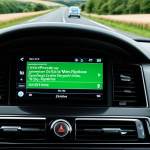Immediate Safety Considerations When Upgrading Your Digital Dashboard
Before diving into a digital dashboard upgrade, conducting an initial safety assessment of your vehicle is paramount. This ensures that the existing electronic systems and wiring won’t conflict, reducing risks of electrical failures or shocks during installation. A thorough pre-upgrade vehicle assessment includes checking battery health and confirming that all dashboard-related components are functioning correctly.
Crucially, disconnecting the vehicle power—usually by removing the battery connection—before starting the installation guards against short circuits and accidental airbag deployment. This simple step is vital in adhering to digital dashboard safety protocols.
Topic to read : Ultimate Guide to Wheel Bearing Maintenance: Protect Your Commercial Truck from Accidents
Equally important is preparing the workspace and personal safety gear. Working in a well-lit, dry environment reduces mishaps caused by poor visibility or environmental hazards. Wearing insulated gloves and protective eyewear adds a protective barrier against potential electric shock or debris.
By following this upgrade safety checklist, you minimize risks associated with handling complex vehicle systems. Prioritizing these safety measures not only protects the installer but also preserves the vehicle’s integrity, paving the way for a smooth dashboard upgrade experience.
Also to see : Essential Safety Insights for Installing Aftermarket Suspension Kits: Avoid Common Pitfalls for a Smooth Ride
Choosing a Safe and Compatible Digital Dashboard
Selecting the right digital dashboard requires thorough verification of digital dashboard compatibility with your vehicle’s make and model. Installing an incompatible system can lead to malfunctions or safety risks, so checking the manufacturer’s specifications and user reviews is crucial.
Prioritising certified dashboard systems and reputable brands enhances safety by ensuring the product meets industry standards. These dashboards often include essential safety features such as clear warning alerts and emergency response integration, which improve driver awareness and reaction times.
When choosing digital dashboards, consider systems that integrate seamlessly with existing vehicle electronics, minimizing risks of interference with airbags or other critical components. Compatibility also impacts the clarity and reliability of displayed information, vital for safe driving.
Understanding the embedded safety features helps drivers stay informed without distraction. Features like customizable alerts and automatic brightness adjustment contribute to both comfort and safety.
In brief, successful dashboard upgrades hinge on selecting compatible, certified products that prioritize user safety and vehicle integrity, laying the foundation for a secure upgrade process.
Minimising Distractions During Operation
Reducing digital dashboard distractions is vital for maintaining driver focus and enhancing road safety. To address this, customizing dashboard settings allows drivers to prioritize essential information while minimizing non-critical alerts. For example, adjusting brightness and disabling non-urgent notifications helps maintain concentration, particularly in challenging lighting conditions.
Voice-control and hands-free features offer practical solutions for interacting with the dashboard without diverting attention. However, their safe use depends on intuitive commands and minimal response delay, ensuring that drivers can keep their eyes on the road.
Clear display design is another cornerstone of safe driving technology. High-contrast screens, straightforward layouts, and strategically prioritized alerts help present information efficiently. This clarity reduces cognitive load, so drivers quickly grasp vital data such as speed, navigation, and system warnings.
A well-configured digital dashboard supports sustained driver attention by limiting unnecessary stimuli and enabling hands-free interaction. Exploring customization options and understanding how to use voice commands safely empowers drivers to maintain focus and respond swiftly to road conditions.
Investing time in these practices aligns with overall digital dashboard safety goals by transforming complex interfaces into user-friendly tools that actively promote attentive, distraction-free driving.
Immediate Safety Considerations When Upgrading Your Digital Dashboard
Upgrading your digital dashboard starts with a meticulous initial safety assessment of your vehicle’s electrical system. This involves inspecting wiring integrity and battery condition to prevent electrical faults during installation. The upgrade safety checklist mandates disconnecting the vehicle power, typically by removing the battery cable, which is essential to avoid short circuits and accidental airbag deployment—risks that could cause personal injury or vehicle damage.
Creating a safe working environment is equally crucial. Ensure your workspace is well-lit and dry, minimizing hazards like slips or accidental contact with live wires. Wearing protective gear, including insulated gloves and safety glasses, provides an additional safety barrier against electric shocks and debris.
Lastly, double-check that your tools are insulated and appropriate for automotive electronics. Using non-specialized tools can increase the risk of damage to sensitive dashboard components or your vehicle’s electrical system. Following this upgrade safety checklist thoroughly helps ensure a smooth upgrade process while safeguarding both installer and vehicle integrity.
Immediate Safety Considerations When Upgrading Your Digital Dashboard
A thorough initial safety assessment is the cornerstone of any successful dashboard upgrade. This involves carefully inspecting existing wiring and electronic components to identify potential hazards such as frayed cables or weak battery connections. Such an assessment reduces the likelihood of electrical faults during your upgrade.
One of the most critical steps highlighted in the upgrade safety checklist is disconnecting the vehicle power before installation. By removing the battery connection, you eliminate risks of short circuits and prevent accidental airbag deployment, which can cause severe injury or vehicle damage. This safety measure is non-negotiable for ensuring a secure working environment.
Equally important is preparing the physical workspace. Adequate lighting and a dry, clutter-free area prevent mishaps like slips or unintended contact with live wires. Wearing protective gear—especially insulated gloves and safety glasses—provides essential protection against electric shocks and debris.
Using properly insulated tools designed for automotive electronics further safeguards sensitive components and reduces the chance of installation errors. Following all these digital dashboard safety protocols systematically ensures both the installer’s safety and the integrity of the vehicle throughout the upgrade process.
Immediate Safety Considerations When Upgrading Your Digital Dashboard
Before beginning a digital dashboard upgrade, conducting an initial safety assessment is essential. This assessment focuses on examining the vehicle’s wiring for damage and verifying battery health to prevent electrical failures. Such thorough pre-upgrade vehicle assessment minimizes risks during installation.
A critical step in the upgrade safety checklist is disconnecting the vehicle power, typically by removing the battery cable. This action eliminates risks of short circuits and accidental airbag deployment, both of which could cause injury or vehicle damage. Many installers underestimate this step’s importance, but it is non-negotiable for digital dashboard safety.
Preparing the workspace also significantly impacts safety. Choose a clean, dry area with sufficient lighting to avoid slips and ensure clear visibility of components. Wearing personal protective equipment, such as insulated gloves and safety glasses, creates a strong barrier against electric shocks and flying debris. Proper tools, specifically insulated ones designed for automotive electronics, further reduce risk.
By integrating these measures into your upgrade safety checklist, you safeguard both yourself and your vehicle. Prioritising an initial safety assessment, disconnecting power, and preparing a secure environment collectively form the foundation of a safe digital dashboard installation process.





